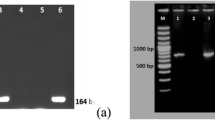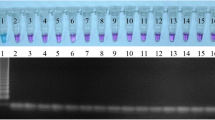Abstract
Purpose
For simultaneous detection of Borrelia miyamotoi (relapsing fever spirochete) and Borrelia burgdorferi sensu lato, we have developed a duplex real-time PCR targeting the flagellin gene (flaB; p41), a locus frequently used in routine diagnostic PCR for B. burgdorferi s.l. detection.
Methods
Primers and probes were designed using multiple alignments of flaB sequences of B. miyamotoi and B. burgdorferi s.l. species. The sensitivity and specificity of primers and probes were determined using serial dilutions (ranging from 104 to 10−1) of B. miyamotoi and B. burgdorferi s.l. DNA and of several species of relapsing fever spirochetes. Conventional PCR on recG and glpQ and sequencing of p41 PCR products were used to confirm the species assignment.
Results
The detection limit of both singleplex and duplex PCR was 10 genome equivalents except for B. spielmanii and two B. garinii genotypes which showed a detection limit of 102 genome equivalents. There was no cross reactivity of the B. miyamotoi primers/probes with B. burgdorferi s.l. DNA, while the B. burgdorferi s.l. primer/probe generated a signal with B. hermsii DNA. Out of 2341 Ixodes ricinus ticks from Germany and Slovakia that were screened simultaneously for the presence of B. miyamotoi and B. burgdorferi s.l., 52 were positive for B. miyamotoi and 276 for B. burgdorferi s.l., denoting an average prevalence of 2.2 % for B. miyamotoi and 11.8 % for B. burgdorferi s.l., and B. miyamotoi DNA was also detectable by PCR using artificial clinical samples.
Conclusion
The duplex real-time PCR developed here represents a method that permits simultaneous detection and differentiation of B. burgdorferi s.l. and B. miyamotoi in environmental and potentially clinical samples.


Similar content being viewed by others
References
Aguero-Rosenfeld ME, Wang G, Schwartz I, Wormser GP. Diagnosis of lyme borreliosis. Clin Microbiol Rev. 2005;18:484–509.
Amore G, Tomassone L, Grego E, Ragagli C, Bertolotti L, Nebbia P, et al. Borrelia lusitaniae in immature Ixodes ricinus (Acari: Ixodidae) feeding on common wall lizards in Tuscany, central Italy. J Med Entomol. 2007;44:303–7.
Bunikis J, Tsao J, Garpmo U, Berglund J, Fish D, Barbour AG. Typing of Borrelia relapsing fever group strains. Emerg Infect Dis. 2004;10:1661–4.
Cochez C, Heyman P, Heylen D, Fonville M, Hengeveld P, Takken W, et al. The presence of Borrelia miyamotoi, a relapsing fever spirochaete, in questing Ixodes ricinus in Belgium and in the Netherlands. Zoonoses Public Health. 2014.
Crowder CD, Carolan HE, Rounds MA, Honig V, Mothes B, Haag H, et al. Prevalence of Borrelia miyamotoi in Ixodes ticks in Europe and the United States. Emerg Infect Dis. 2014;20:1678–82.
De Michelis S, Sewell HS, Collares-Pereira M, Santos-Reis M, Schouls LM, Benes V, et al. Genetic diversity of Borrelia burgdorferi sensu lato in ticks from mainland Portugal. J Clin Microbiol. 2000;38:2128–33.
Dsouli N, Younsi-Kabachii H, Postic D, Nouira S, Gern L, Bouattour A. Reservoir role of lizard Psammodromus algirus in transmission cycle of Borrelia burgdorferi sensu lato (Spirochaetaceae) in Tunisia. J Med Entomol. 2006;43:737–42.
Fraenkel CJ, Garpmo U, Berglund J. Determination of novel Borrelia genospecies in Swedish Ixodes ricinus ticks. J Clin Microbiol. 2002;40:3308–12.
Fukunaga M, Koreki Y. The flagellin gene of Borrelia miyamotoi sp. nov. and its phylogenetic relationship among Borrelia species. FEMS Microbiol Lett. 1995;134:255–8.
Geller J, Nazarova L, Katargina O, Järvekülg L, Fomenko N, Golovljova I. Detection and genetic characterization of relapsing fever spirochete Borrelia miyamotoi in Estonian ticks. PLoS One. 2012;7:e51914.
Gugliotta JL, Goethert HK, Berardi VP, Telford SR 3rd. Meningoencephalitis from Borrelia miyamotoi in an immunocompromised patient. N Engl J Med. 2013;368:240–5.
Guy EC, Stanek G. Detection of Borrelia burgdorferi in patients with Lyme disease by the polymerase chain reaction. J Clin Pathol. 1991;44:610–1.
Hanincova K, Schafer SM, Etti S, Sewell HS, Taragelova V, Ziak D, et al. Association of Borrelia afzelii with rodents in Europe. Parasitology. 2003;126:11–20.
Hovius JW, de Wever B, Sohne M, Brouwer MC, Coumou J, Wagemakers A, et al. A case of meningoencephalitis by the relapsing fever spirochaete Borrelia miyamotoi in Europe. Lancet. 2013;382:658.
Krause PJ, Fish D, Narasimhan S, Barbour AG. Borrelia miyamotoi infection in nature and in humans. Clin Microbiol Infect. 2015. doi:10.1016/j.cmi.2015.02.006.
Krause PJ, Narasimhan S, Wormser GP, Rollend L, Fikrig E, Lepore T, et al. Human Borrelia miyamotoi Infection in the United States. N Engl J Med. 2013;368:290–1.
Kumar S, Tamura K, Nei M. Integrated software for molecular evolutionary genetics analysis and sequence alignment. Brief Bioinform. 2004;5:150–63.
Maraspin V, Ogrinc K, Ruzic-Sabljic E, Lotric-Furlan S, Strle F. Isolation of Borrelia burgdorferi sensu lato from blood of adult patients with borrelial lymphocytoma, Lyme neuroborreliosis, Lyme arthritis and acrodermatitis chronica atrophicans. Infection. 2011;39:35–40.
Margos G, Stockmeier S, Hizo-Teufel C, Hepner S, Fish D, Dautel H, et al. Long-term in vitro cultivation of Borrelia miyamotoi. Ticks Tick Borne Dis. 2015;6:181–4.
Margos G, Vollmer SA, Cornet M, Garnier M, Fingerle V, Wilske B, et al. A new Borrelia species defined by multilocus sequence analysis of housekeeping genes. Appl Environ Microbiol. 2009;75:5410–6.
Masuzawa T. Terrestrial distribution of the Lyme borreliosis agent Borrelia burgdorferi sensu lato in East Asia. Jpn J Infect Dis. 2004;57:229–35.
Ornstein K, Barbour AG. A reverse transcriptase-polymerase chain reaction assay of Borrelia burgdorferi 16S rRNA for highly sensitive quantification of pathogen load in a vector. Vector Borne Zoonotic Dis. 2006;6:103–12.
Platonov AE, Karan LS, Kolyasnikova NM, Makhneva NA, Toporkova MG, Maleev VV, et al. Humans infected with relapsing fever spirochete Borrelia miyamotoi. Russia. Emerg Infect Dis. 2011;17:1816–23.
Richter D, Schlee DB, Matuschka FR. Relapsing fever-like spirochetes infecting European vector tick of Lyme disease agent. Emerg Infect Dis. 2003;9:697–701.
Sato K, Takano A, Konnai S, Nakao M, Ito T, Koyama K, et al. Human infections with Borrelia miyamotoi. Japan. Emerg Infect Dis. 2014;20:1391–3.
Schwaiger M, Peter O, Cassinotti P. Routine diagnosis of Borrelia burgdorferi (sensu lato) infections using a real-time PCR assay. Clin Microbiol Infect. 2001;7:461–9.
Schwarz A, Honig V, Vavruskova Z, Grubhoffer L, Balczun C, Albring A, et al. Abundance of Ixodes ricinus and prevalence of Borrelia burgdorferi s.l. in the nature reserve Siebengebirge, Germany, in comparison to three former studies from 1978 onwards. Parasit Vectors. 2012;5:268.
Scoles GA, Papero M, Beati L, Fish D. A relapsing fever group spirochete transmitted by Ixodes scapularis ticks. Vector Borne Zoonotic Dis. 2001;1:21–34.
Takano A, Toyomane K, Konnai S, Ohashi K, Nakao M, Ito T, et al. Tick surveillance for relapsing fever spirochete Borrelia miyamotoi in Hokkaido, Japan. PLoS One. 2014;9:e104532.
Taylor KR, Takano A, Konnai S, Shimozuru M, Kawabata H, Tsubota T. Borrelia miyamotoi infections among wild rodents show age and month independence and correlation with Ixodes persulcatus larval attachment in Hokkaido. Japan. Vector Borne Zoonotic Dis. 2013;13:92–7.
Tsao JI, Wootton JT, Bunikis J, Luna MG, Fish D, Barbour AG. An ecological approach to preventing human infection: vaccinating wild mouse reservoirs intervenes in the Lyme disease cycle. Proc Natl Acad Sci U S A. 2004;101:18159–64.
Ullmann AJ, Gabitzsch ES, Schulze TL, Zeidner NS, Piesman J. Three multiplex assays for detection of Borrelia burgdorferi sensu lato and Borrelia miyamotoi sensu lato in field-collected ixodes nymphs in North America. J Med Entomol. 2005;42:1057–62.
Vitorino LR, Margos G, Feil EJ, Collares-Pereira M, Ze-Ze L, Kurtenbach K. Fine-scale phylogeographic structure of Borrelia lusitaniae revealed by multilocus sequence typing. PLoS ONE. 2008;3:e4002.
Yossepowitch O, Gottesman T, Schwartz-Harari O, Soroksky A, Dan M. Aseptic meningitis and adult respiratory distress syndrome caused by Borrelia persica. Infection. 2012;40:695–7.
Acknowledgments
The authors would like to acknowledge Cecilia Hizo-Teufel, Sylvia Stockmeier, Katja Meindl, Sabine Wolf, Jasmin Fräßdorf, A. Muminovic, AK Steinmann, Claudia Brefeld, and Simone Hanisch for excellent technical assistance. The work was partially funded by the Scientific Grant Agency of the Ministry of Education, science, research and sport of the Slovak Republic and the Slovak Academy of Sciences, Project VEGA No. 2/0108/13. This study was partially funded by EUgrant FP7-261504 EDENext and is cataloged by the EDENext Steering Committee (http:/www.edenext.eu/). The contents of this publication are the sole responsibility of the authors and do not necessarily reflect the views of the European Commission. The work of CS was done under the frame of EurNegVec COST Action TD1303. V. Fingerle, G. Margos, and M. Derdakova are the members of ESGBOR.
Conflict of interest
The authors declare no conflict of interest.
Author information
Authors and Affiliations
Corresponding author
Additional information
R. Venczel and L. Knoke contributed equally to this work.
Electronic supplementary material
Below is the link to the electronic supplementary material.
Rights and permissions
About this article
Cite this article
Venczel, R., Knoke, L., Pavlovic, M. et al. A novel duplex real-time PCR permits simultaneous detection and differentiation of Borrelia miyamotoi and Borrelia burgdorferi sensu lato. Infection 44, 47–55 (2016). https://doi.org/10.1007/s15010-015-0820-8
Received:
Accepted:
Published:
Issue Date:
DOI: https://doi.org/10.1007/s15010-015-0820-8




